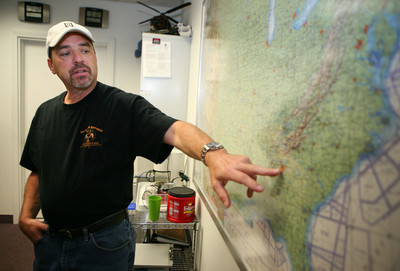Air-traffic control plan stalled by funding fight
Pilot Michael Adams says he can have his client's private jet ready for takeoff in just 15 minutes.
But once he rolls out of a private hangar near McCarran International Airport it can take just as long or longer to get in the air if the jet is stuck behind dozens of commercial airliners waiting to fly from Las Vegas during peak times.
"We'll sit here on the ground until they unload all the airliners before they let us go," said Adams, who pilots a private jet for the executive of a large Las Vegas company.
Unfortunately for anybody who flies in and out of McCarran, or any other major airport, a proposal the Federal Aviation Administration says would speed air travel for everyone is stuck in limbo as airlines fight with advocates for general aviation fliers like Adams over who should pay for the improvements.
Right now Congress is on Adams' side.
The House of Representatives recently approved a bill that would reauthorize funding for the FAA, including money to pay for an upgrade to the air traffic control system called the Next Generation Air Transportation System, or Next Gen, for short. A Senate committee passed a similar bill.
The House version eschews proposed new user fees the FAA and major airlines want to apply to general aviation flights that use the nation's largest airports. Both increase fuel taxes.
Fee supporters highlighted the increasing popularity of corporate jets as a major reason for rising air travel delays and suggested new fees would shift more of the burden for an air traffic control upgrade from commercial passengers to private plane users.
The shift is a matter of fairness, they argue.
That's because a small private jet with just a few passengers requires just as many resources to get in and out of an airport as a Boeing 737. But the 737 seats as many as 137 people, each of whom pays a ticket tax that supports the FAA.
"We are after the corporate jets," FAA spokeswoman Diane Spitaliere said. "They are adding to the congestion problem but they are not paying their fair share."
To support that claim, the FAA and major airlines say private aviation is responsible for 16 percent of the cost of running the air traffic control system but the fuel taxes that sector pays cover just 3 percent of the cost.
Private aviation advocates disagree.
They cite their own interpretation of FAA funding that says private aviation is responsible for 7 percent to 9 percent of the cost of operating the air traffic control system and pays 8.6 percent of the bill.
Selena Shilad, executive director of the Alliance for Aviation Across America, likened the increased fuel tax as a "pay at the pump" system that is easy for general aviation pilots and owners to manage.
Shilad said new user fees that would replace a tax on commercial airline tickets would amount to a tax break for big airlines and create new bureaucracy for general aviation.
"Imagine you are going to get a bill three months down the road every time you get in your car," Shilad said. "That is a huge administrative burden."
The FAA's current funding system expires Sunday. But the House and Senate both approved an extension to maintain the current system.
That leaves passengers and airport operators to wait for a resolution that could lead to new funding and, perhaps, an upgraded air traffic control system that could reduce delays for all aircraft.
"We don't care how they fund NextGen," said Rosemary Vassiliadis, deputy director of the Clark County Department of Aviation. "But we need Congress to get this to pass."


















